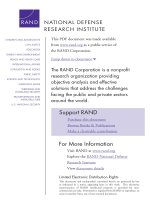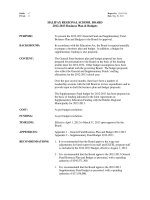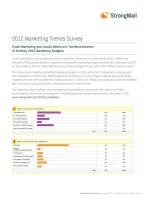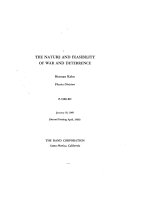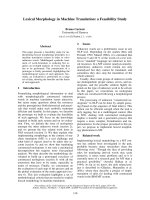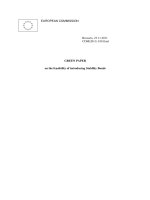Budgets feasibility
Bạn đang xem bản rút gọn của tài liệu. Xem và tải ngay bản đầy đủ của tài liệu tại đây (264.12 KB, 7 trang )
<span class="text_page_counter">Trang 1</span><div class="page_container" data-page="1">
Hayes Company, sales volume is expected to be 3,000 units in the first quarter with 500-unit increments in each succeeding quarter. Based on a sales price of 60 L.E per unit, the sales budget for the year, by quarters, is shown in following.
<small>Expected unit sales Unit selling price Total sales 180,000 L.E 210,000 L.E 240,000 L.E 270,000 L.E 900,000 L.E </small>
Hayes Company believes it can meet future sales requirements by maintaining an ending inventory equal to 20 percent of the next quarter's budgeted sales volume. For example, the ending finished goods inventory for the first quarter is 700 units (20% ×anticipated second-quarter sales of 3,500 units). The production budget is shown in the following Illustration. <small>Total required units </small>
<small>Less: Beginning finished goods </small>
<b><small>Required production units 3,100 3,600 4,100 4,600 15,400 </small></b>
<small>a20% of next quarter's sales. </small>
<small>bExpected 2006 first-quarter sales, 5,000 units ×20%. c20% of estimated first-quarter 2005 sales units. </small>
</div><span class="text_page_counter">Trang 2</span><div class="page_container" data-page="2">Hayes Company has found that an ending inventory of raw materials equal to 10 percent of the next quarter's production is sufficient. The manufacture of each kitchen-mate requires 2 pounds of raw materials, and the expected cost per pound is 4 L.E. The direct materials budget is show in as the following.
Direct Materials Budget
For the Year Ending December 31, 2005 <small>Total materials required </small>
<small>Less: Beginning direct materials Direct materials purchases </small>
<small>Cost per pound </small>
<b><small>Total cost of direct materials </small></b>
<b><small>purchases 25,200L.E 29,200L.E 33,200L.E 37,200L.E 124,800L.E </small></b>
<small>a 10% of next quarter's production </small>
<small>b Estimated 2006 first-quarter pounds needed for production, 10,200 ×10% c 10% of estimated first-quarter pounds needed for production </small>
<i><b>Direct Labor Budget </b></i>
At Hayes Company, two hours of direct labor are required to produce each unit of finished goods. The anticipated hourly wage rate is 10 L.E. These data are shown in following Illustration.
</div><span class="text_page_counter">Trang 3</span><div class="page_container" data-page="3">Direct Labor Budget
For the Year Ending December 31, 2005 <small>Total required direct labor hours </small>
<small>Direct labor cost per hour </small>
<b><small>Total direct labor cost 62,000L.E 72,000L.E 82,000L.E 92,000L.E 308,000L.E </small></b>
At Hayes Company, overhead is applied to production on the basis of direct labor hours. Thus, as shown in following Illustration, the annual rate is 8 L.E per hour (246,400 L.E ÷30,800).
Manufacturing Overhead Budget For the Year Ending December 31, 2005
<b><small>Total manufacturing overhead 57,100L.E 60,100L.E 63,100L.E 66,00L.E 246,400L.E </small></b>
<b><small>Manufacturing overhead rate </small></b>
</div><span class="text_page_counter">Trang 4</span><div class="page_container" data-page="4">the variable expense rates per unit of sales are sales commissions 3.00 L.E and freight-out 1.00 L.E. Variable expenses per quarter are based on the unit sales from the sales budget. For example, sales in the first quarter are expected to be 3,000 units. Thus, Sales Commissions Expense is 9,000 L.E (3,000×3 L.E), and Freight-out is 3,000 L.E (3,000 ×1 L.E). Fixed expenses are based on assumed data. The selling and administrative expense budget is shown in the following Illustration.
Selling and Administrative Expense Budget For the Year Ending December 31, 2005
<b><small>Total selling and </small></b>
<b><small>administrative expenses 42,000L.E 44,000L.E 46,000L.E 48,000L.E 180,000L.E </small></b>
to find the cost of goods sold, it is first necessary to determine the total unit cost of producing one Kitchen-mate, as follows.
Cost of goods sold can then be determined by multiplying the units sold by the unit cost. For Hayes Company, budgeted cost of goods sold is 660,000 L.E (15,000 ×44 L.E).
</div><span class="text_page_counter">Trang 5</span><div class="page_container" data-page="5">All data for the statement are obtained from the individual operating budgets except the following:
1. Interest expense is expected to be 100 L.E. 2. Income taxes are estimated to be 12,000 L.E.
The budgeted income statement is shown in the following Illustration.
<b>HAYES COMPANY </b>
Budgeted Income Statement For the Year Ending December 31, 2005 <small>Income before income taxes </small>
<small>Income taxes expense </small>
<small>59,900 12,000 </small>
<i><b>Cash Budget </b></i>
<b> The cash budget shows anticipated cash flows. Because cash is so vital, this </b>
budget is considered to be the most important output in preparing financial budgets. The cash budget contains three sections (cash receipts, cash disbursements, and financing) and the beginning and ending cash balances, as shown in the following Illustration.
To minimize detail, we will assume that Hayes Company prepares an annual cash budget by quarters. The cash budget for Hayes Company is based on the following assumptions.
1. The January 1, 2005, cash balance is expected to be 38,000 L.E.
2. Sales: 60 percent are collected in the quarter sold and 40 percent are collected in the following quarter. Accounts receivable of 60,000 L.E at December 31, 2004, are expected to be collected in full in the first quarter of 2005.
</div><span class="text_page_counter">Trang 6</span><div class="page_container" data-page="6">3. Short-term investments are expected to be sold for 2,000 L.E cash in the first quarter.
4. Direct materials: 50 percent are paid in the quarter purchased and 50 percent are paid in the following quarter. Accounts payable of 10,600 L.E at December 31, 2004, is expected to be paid in full in the first quarter of 2005. 5. Direct labor: 100 percent is paid in the quarter incurred.
6. Manufacturing overhead and selling and administrative expenses: All items except depreciation are paid in the quarter incurred.
7. Management plans to purchase a truck in the second quarter for 10,000 L.E cash.
8. Hayes makes equal quarterly payments of its estimated annual income taxes. 9. Loans are repaid in the earliest quarter in which there is sufficient cash (i.e., when the cash on hand exceeds the 15,000 L.E minimum required balance). In preparing the cash budget, it is useful to prepare schedules for collections from customers (assumption No. 2, above) and cash payments for direct materials (assumption No. 4, above). The schedules are shown as follow.
The cash budget for Hayes Company is shown in the following Illustration. The budget indicates that 3,000 L.E of financing will be needed in the second quarter to maintain a minimum cash balance of 15,000 L.E. Since there is an excess of available cash over disbursements of 22,500 L.E at the end of the third quarter, the borrowing is repaid in this quarter plus 100 L.E interest.
Schedule of Expected Collections from Customers
<b><small>Quarter </small></b>
<small>Accounts receivable, 12/31/04 First quarter (180,000 L.E) Second quarter (210,000 L.E) Third quarter (240,000 L.E) Fourth quarter (270,000 L.E) </small>
</div><span class="text_page_counter">Trang 7</span><div class="page_container" data-page="7"><small>Schedule of Expected Payments for Direct Material </small>
<b><small>Quarter </small></b>
<small>Accounts payable, 12/31/04 First quarter (25,200 L.E) Second quarter (29,200 L.E) Third quarter (33,200 L.E) Fourth quarter (37,200 L.E) </small>
<small>Collections from customers </small>
<small>157,100 L.E – 3,800 L.E depreciation </small>
<small>242,000 L.E – 1,000 L.E depreciation </small>
</div>
